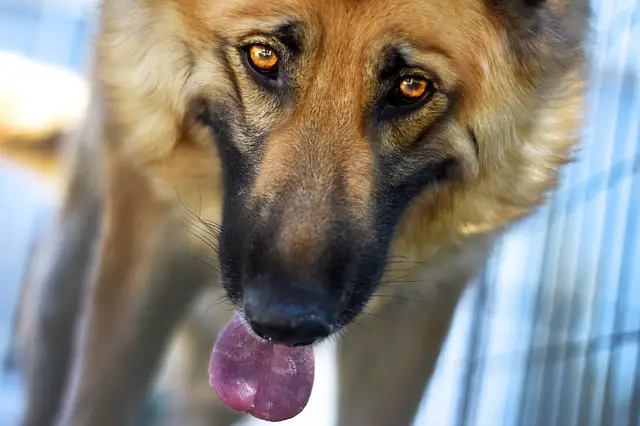Service dogs are a vital part of the lives of people living daily with a disability. The top three breeds of dogs trained and utilized as service dogs are the Golden retriever, the Labrador retriever, and the German shepherd.
The German shepherd often works as a search and rescue dog and as a military and police canine.
As working dogs, some of their most important endeavors deal with helping and guiding the disabled, hearing, and seeing impaired, along with giving their owners life of independence and dignity.
The Seeing Eye, in Morristown, New Jersey, carries on the work and training of co-founder Morris Frank, who received the first guide dog, Buddy, in 1928.
In 1929, Frank, along with Dorothy Harrison Eustis, who trained German shepherds in Switzerland, established The Seeing Eye, a guide dog school, in Nashville, Tennessee that was later moved to New Jersey in 1931.
German shepherds help guide the blind with their keen eyes and intelligence. Who would think these steadfast shepherds can also suffer from eye problems and diseases with some leading to blindness?
In the following post, I will give you some information on German shepherd eye problems and a disease called pannus as well as German shepherd pannus treatment.

For your dog’s vitamin supplement, food, toys, or other dogs product please visit the Sundays for Dogs website.
German Shepherd Eye Color
Almost all German shepherds you’ve seen have probably had brown eyes and this is most common for the breed. You may have seen one with blue eyes or one blue eye and one brown and assumed that they were not a purebred shepherd.
If you’re wondering if German shepherds can have blue eyes, the answer is yes. This, however, is a very rare occurrence and is the result of a genetic variation.
German shepherds with blue eyes are known as “blue” German shepherds. Along with the blue eyes, the darker fur that shepherds have can appear blue also because of the recessive gene that gives them their blue eyes.
Many owners consider this blue-eyed trait striking, while breeders view it as a defect. Eye color in German shepherds, either brown or blue, does not contribute to any disease or eye problems they may acquire.
To check your shepherds’ health status or their DNA checks, please visit the Embark vet website for all the help you may need.
German Shepherd Eye Problems
German shepherds can suffer from a variety of eye problems and diseases, but this is not definite for every shepherd, in fact, your German shepherd may never have any eye issues.
Some of these problems can be prevented with proper health care and nutrition, while others are inherited. Below are a few eye problems and diseases with symptoms to watch for.
Allergies
Although allergies in themselves are not eye diseases, they can create eye symptoms. These symptoms may be watery, red eyes with a discharge along with a runny nose and sneezing, just as in humans.
Your shepherd may suffer from inhalant or environmental allergies, which sometimes are one and the same.
Something that your pup inhales in the environment may be the trigger, such as dust, mold, perfume, grass, plants, and pollen. Allergy medication would be the answer.
Corneal Dystrophy
This can affect more than one layer of your shepherd’s eyes and is an inherited disorder. It usually occurs in both eyes and is caused by high levels of calcium and cholesterol which can be checked by a blood test.
It can be detected in breeds at any age but is common in the geriatric canine. It rarely causes blindness but some visual impairment is possible. This can be treated by diet, medication, or sometimes surgery.
PRA Progressive Retinal Atrophy
Atrophy means the wasting away of something and with PRA, your German shepherd’s retina begins to waste away, beginning with night blindness and eventual failure of vision.
This is an inherited disease with the affected shepherd acquiring this through a defective gene from both parents. There is no cure for this. Dogs will usually adapt to this gradual vision loss with the help of their pet parents.
Glaucoma
This is an eye disease that causes pain, discomfort, and German shepherd red eyes. It is caused by the pressure of the fluid on the eye and if it is not treated promptly will cause damage to the optic nerve and retina, causing blindness. Treatments are eye drops and often surgery.
Cataracts
Cataracts can occur in dogs, just as in humans. German shepherds, usually develop in senior dogs and you will notice cloudy, filmy eyes.
Vision will be blurry and cloudy as well and surgery is an option. Cataracts can occur in one or both eyes.
Achromatopsia
This is an abnormality of the retina found in German shepherds and causes your shepherd to be unable to see color in the bright daytime light as well as have blurred vision.
It is sometimes called canine-day blindness. The only treatment offered is in young shepherds where a type of gene therapy has been promising.
Plasma Cell Conjunctivitis
This type of conjunctivitis is an autoimmune infection that occurs in German shepherds and causes inflamed and moist tissues of the eye. Antibiotic eye drops or oral antibiotics are the treatments of choice.

Pannus in German Shepherds
Pannus is a common autoimmune disease in German shepherds and causes the immune system to attack the eye.
A change in the eye occurs progressively and scar tissue and blood vessels infiltrate the cornea and can result in blindness if the entire surface of the cornea becomes affected.
Pannus, also known as superficial keratitis, affects both eyes and is known to be a hereditary condition. Below is some information about pannus as well as symptoms and treatment options.
- German shepherds who are diagnosed with pannus at an early age have a more severe effect and are less responsive to treatments.
- Middle-aged German shepherds seem to be affected more frequently due to an inadequate immune system.
- German shepherds between 4 and 7 years of age have a greater chance of developing pannus.
- It is believed that high levels of exposure to UV or ultraviolet sunlight increase the chance of a German shepherd being affected by pannus. Areas that find more German shepherds suffering from this condition are high-altitude locations where there is plenty of sunlight such as New Mexico, Arizona, and the Rocky Mountains.

Symptoms of pannus
- Watery Eyes
- Inflammation of the third eyelid
- White spots around the eyes
- Clouded cornea and discoloration
- Red, Bloodshot eyes
- Cloudy blood vessels, evident in the cornea
- Corneal pigmentation that is black or dark brown
Treatment for pannus
At this time there is no known cure for pannus in German shepherds, but listed below are treatment options.
- Topical steroids – If pannus is diagnosed in your German shepherd early on, topical steroid cream such as prednisone or dexamethasone can decrease inflammation.
- Injections with steroids – Injections of steroids along with topical steroids can be used to stop or slow down the progress of the pannus.
- Sunglasses – Even though this sounds odd, goggles for your German shepherd are quite a serviceable way to keep the disease from progressing by filtering out harmful UV rays and at the same time keeping out dust and dirt from the wind. Avoiding direct sunlight, perhaps by walking after the sun has set is helpful to avoid the harsh daytime sun.
- Antibiotics – Other eye infections can occur along with pannus and antibiotic eye drops or oral antibiotics may be needed to control these.
- Immunosuppressants – A newer option that shows promise is immunosuppressant eye drops which include different percentages of cyclosporine and help with the dark pigmentation changes and scarring that are caused by pannus.
- Surgery – Surgery for the pannus can only be performed one time and should be considered carefully. It can greatly help your German shepherd’s declining eyesight by removal of a layer of the cornea. The negative to the surgery is that it is short-lived as pannus generally reoccurs.
- Radiation – A type of radiation called beta radiation is usually the last resort when the pannus has become advanced. This radiation decreases blood vessels in the cornea.
Some of the eye disorders and diseases above can be prevented, while others are inherited with a genetic background. Seeking out a reputable breeder will be half the battle to avoid eye issues.
Being diligent with a high-quality diet, exercise and veterinary care are the other half of sidestepping eye problems and all-around health issues.
Regular veterinary wellness visits are essential in pinpointing and diagnosing any overall health issue and treating it before it is full-blown.
These eye diseases may never occur in your German shepherd, but it’s good to be prepared and know the symptoms.
